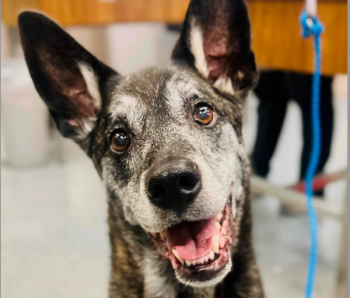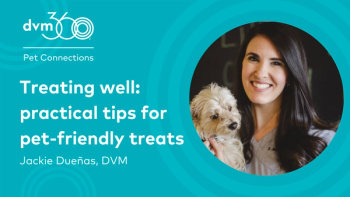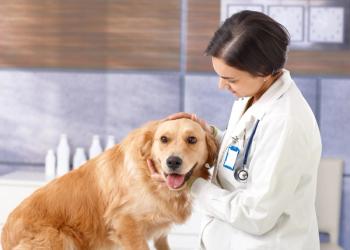
Advances in pet cancer: Innovation in research, scientific collaboration, therapy, and prevention
A group of veterinary experts in oncology met to discuss the innovative research, new technology, medical advances, and important collaborations occurring in pet cancer diagnostics and treatment, with a focus on the benefits for general practitioners, their clients, and patients.
“Having worked in veterinary oncology for 30 years, the future looks brighter than ever before. There are advances being made in molecular diagnostics, genomics, and proteomics that give me such incredible hope that we'll be able to treat and eventually cure the majority of cancers that we see.”
-Gerald Post, DVM, MEM, DACVIM (Oncology), Practice Owner, The Veterinary Cancer Center, Norwalk, CT
“Many pet owners have a perception that the advances happening in veterinary medicine arise from progress made in the human field. However, research in veterinary oncology is itself a tremendously productive area of activity that is increasingly well-received by, and relevant to, the human medical community.”
-Rachael Thomas, PhD, Research Assistant Professor, Genomics, College of Veterinary Medicine, North Carolina State University, Raleigh, NC
It is a terrible fact that cancer is the #1 disease-related killer of dogs and cats. It cuts short the lives of beloved pets who are already too-short-lived in the opinion of their human companions. But scientists in both human medical and veterinary medical research laboratories around the country are working diligently to conquer the scourge of cancer and improve the quality of life of patients living with a cancer diagnosis. And the “C-word” is no longer necessarily a death sentence for pets. There are many new diagnostic and therapeutic advances being made that general practitioners should be aware of.
In the summer of 2016,
What recent advances in pet oncology have had the greatest impact on pets and clients?
Dr. Kim Cronin: I agree. A lot of the prices have started to come down, and it's in line with what our clients are now able to afford. The other exciting thing is that a number of companies have really stepped up to the plate, and they're now looking to commit significant resources and money to the field of veterinary oncology.
Dr. Jackie Wypij: Diagnostics and other tools are now in the hands of veterinarians with more training and more safety. So clients and pets benefit, which I think is wonderful.
Dr. David Waters: I think the other thing that feeds into this is the concept that the “C-word” is no longer equivalent to a death sentence. Therefore, clients are interested in pursuing diagnostics. Also, you have an increased accessibility to specialists and many more board-certified oncologists that can either do the work or consult with general practitioners.
Dr. Post: The two things I say most often in my job are, “Cancer is not a death sentence,” and “Age is not a disease.” As our clients see their friends and family members living longer with cancer, and even beating cancer, they believe maybe that's also true for their pets.
Dr. Rachael Thomas: And patients can still maintain a good quality of life during that period.
Dr. Wypij: That's where medications are changing, too. Instead of saying, “What drug can we give that's going to kill cancer cells?” we say, “Can we target the cancer and can we stimulate the body systems to help us?” That change is being driven by what we can use to regulate the process, not what we can use to kill this thing.
Dr. Cronin: That's where a lot of the molecular biology and genetics research comes in. We want to find out exactly what it is that has been dysregulated so that we can figure out how we can change it or re-regulate it so that it's no longer an uncontrolled process.
What new pet cancer research is on the horizon? How will that change the landscape for veterinarians and their clients?
Dr. Post: Immuno-oncology and genomics are the two big advancements in veterinary oncology on the horizon. Checkpoint inhibitors have revolutionized some human cancer treatments and are being actively developed for veterinary use. Certainly genomics-whether it be sequencing of tumors or gene expression analysis-are here and being used in veterinary medicine.
Dr. Thomas: The ongoing refinement of canine and feline genomic sequence assemblies enables the veterinary community to move toward new diagnostic and prognostic tools that are incredibly sensitive but also incredibly rapid. Because of that, we can provide clinicians and pet owners with prompt feedback that allows them to assess the collective impact of a series of integrated tests, all within a relatively short period of time. The ability to use genomics as a mechanism for early detection is tremendously powerful, and becoming more so.
Dr. Waters: So the idea behind genomics, the rationale perhaps, is driven by heterogeneity. Heterogeneity is the hallmark of cancer. We need to move beyond the more primitive idea of organ-based classification of tumors to molecular signature. Genomics is the way to look inside the tumor and ask, “What is this particular patient's tumor?” It is consistent with the whole idea of personalized medicine. I think that's where things are moving. We're only going to be as good as our categories. Today, we say breast cancer, osteosarcoma, or whatever, instead of saying, “Here is this tumor's molecular signature. Here are the potential targets for this particular patient's tumor.” The genomics will bring us the information so that we can grow increasingly sophisticated categories. Back in the day, leukemia was one disease; now, we see it as 15 different diseases.
Dr. Cronin: In the past, lymphoma was treated as one disease in dogs. Now with some of the diagnostics being so accessible, like flow cytometry and PARR (PCR for antigen receptor rearrangements), we know that golden retrievers have their own unique form of T-cell lymphoma that has a very different prognosis. I think that we need to look at other cancers in a similar fashion, which will allow us to tailor treatment to the patient and give owners more accurate information about the prognosis. The other thing is that the focus of research now is turning away from chemotherapy. Things like immunotherapy and small molecule inhibitors are now giving you different therapeutic options that may be more effective and have fewer side effects.
Dr. Wypij: Another huge advancement is collaboration. It's no longer individual researchers working on their project. Now we have projects such as the Comparative Oncology Trials Consortium (COTC) that utilizes the combined resources of multiple institutions. (See
Dr. Waters: To achieve better cancer control, we should be looking beyond better cancer treatment and diagnostics to the idea of cancer prevention. We're pretty primitive in our thinking about this, I believe. A key question arises: Should the prime goal of cancer control research be the avoidance of cancer development or the avoidance of cancer mortality? I believe the second goal is a much more realistic one to achieve. And if we set this as our goal, we will need to take creative steps to confront the difficulty of finding cancer-resistant populations for study. In veterinary medicine, the ongoing investigation of highly successful aging in Rottweilers is directly addressing this challenge-studying in detail those individuals within a cancer-prone breed who are resistant to cancer mortality.2,3
Pet cancer resources - Learn more
Golden Retriever Lifetime Study
The Morris Animal Foundation's Golden Retriever Lifetime Study is the largest and longest observational study ever undertaken in the U.S. to improve the health of dogs.
The study is dedicated to helping better understand and explain why diseases, including cancer, develop and provide clues about how diet, exercise, environment, and genetics may impact lifelong health and well-being.
The study, launched in 2012 and fully enrolled in 2015, follows more than 3,000 golden retrievers throughout their lives. At annual visits, study veterinarians take blood, nail clippings, fur, and other samples and also complete a veterinary questionnaire for the canine participants. Collected data are evaluated continually by veterinary epidemiologists.
The study is supported by ongoing fundraising efforts and sponsors including The Blue Buffalo Foundation. To learn more, visit
Pet Cancer Awareness Program
Blue Buffalo Company created the Blue Buffalo Foundation and the Pet Cancer Awareness Program (PCA) in 2003 to raise awareness, provide information, and help find a cure for cancer.
Cancer is the #1 disease-related killer of dogs and cats. By generating greater awareness of the early warning signs, the Foundation is helping clients take the first steps toward protecting their beloved pets.
Information is critical. The more veterinary clients know about how to reduce the cancer risk to their pets, and what to do if their dog or cat develops cancer, the more they are empowered to help.
Research is expensive. PCA helps fund universities and clinics that study the causes, prevention, and treatment of canine and feline cancer. The Foundation also raises funds to support organizations that help needy families cover costly pet cancer treatments they otherwise couldn't afford. With the help of Petco, the Blue Buffalo Foundation and the Petco Foundation have become the leading contributors to pet cancer research. To learn more, visit
Blue Buffalo Veterinary Clinical Trials Office
The Clinical Trials Office (CTO) at The Ohio State University College of Veterinary Medicine was established in 2007 and now oversees more than 35 clinical trials each year. These studies have resulted in the development of new treatments for cancer (lymphoma, nasal cancer), heart disease, and arthritis.
In May 2016, Blue Buffalo Company announced it will award a $6 million gift to support the growth of the CTO, a program that facilitates studies to improve patient care and advance medical knowledge for both animals and people.
Veterinarians and veterinary technicians in the CTO work closely with faculty, staff, residents, and interns at the Veterinary Medical Center, as well as with participating clinics to oversee clinical trials and ensure the highest standard of patient care. To learn more, visit
Dr. Post: Yes. What better way to find information about either cancer resistance or susceptibility than to study dogs, where you can get an answer in 10 to 20 years, when it would take 50 to 100 years, or longer, to get the same answer in people. Also, with dogs, you can study their environment and what they eat to a much greater extent. I believe what's missing is a more extensive collection of baseline epidemiologic data. For the most part, we don't know what the risks are of, say, an average golden retriever getting T-cell or B-cell lymphoma. The Golden Retriever Lifetime Study by the Morris Animal Foundation intends to answer at least some of these questions. (For more information, see the sidebar “Pet Cancer Resources-Learn More” at right or visit
Dr. Cronin: The other hard part is that your susceptibility to cancer is not only from your genetics, but also from your environment, your diet, your exercise, and general lifestyle. There are so many complex interactions; it's really hard to tease out one specific thing and say it is a cause, even when it comes to diet.
Dr. Thomas: We participated in a study looking at risk factors for lymphoma and hemangiosarcoma in golden retrievers.4 There were some powerful genomic risk factors in both, but equally there was disease that could not be predicted on the basis of heritable genomic signatures alone. What's also evident from this kind of approach is that when you apply potential risk factors to populations outside the geographic area that you studied, you can start to see some differences. Looking at U.S. versus European pet populations, for example, you can identify confounding cultural factors from how people interact with their pets, how pets are housed, trends in their diet, as well as their level of exercise, and spay/neuter status-all of which can vary based on geography.
Dr. Wypij: Unfortunately, we often don't have information about the pet's lifestyle because so many of our patients are rescued. Advancement would also require improved communication and the ability to transfer the animal's life history and medical history along with them. Sure, I can tell what they're eating right now, but I've only known them for six months.
Dr. Post: But most people own their pets from puppyhood. If there was a way for owners to input answers to questions on their smartphones every six months or so, which would then be portable, no matter where they went, and accessible by every veterinarian, the amount of information we could gather would be huge. It's a challenge, but I think the solution to the problem is technologically available.
Dr. Thomas: The enthusiasm with which the typical pet owner just gives you whatever information you ask for in these kinds of studies is incredible. We have this amazing community of people who are so willing to impart information. It is the responsibility of veterinary researchers to establish what information should be prioritized and come up with some well-powered, well-designed studies and questions that will predict the factors that we're not even currently thinking about, but that we do need to think about further down the line.
What role does nutrition play in lowering the risk of cancer in dogs and cats?
Dr. Post: I think nutrition plays a major role in affecting our risk of cancer. The problem is: How do we prove that? Again, the dog is a fantastic model to answer that question, if we believe that nutrition plays a key role. Here we have an opportunity to better understand the role that our nutritional choices play in either increasing or decreasing the risk of cancer.
Dr. Cronin: I do think of nutrition as being very important-not only what dogs should eat before they get cancer, but what they should eat after they get cancer. That is the #1 question we are asked by our clients: Should I change their diet? What should I feed them? There's not a lot out there about it. I think diet is an area where there's a huge opportunity for research, and it's what our clients want to know.
Dr. Wypij: In a recent Canadian study,5 about 25% of clients had changed their pet's diet related to a diagnosis of cancer, somewhat in response to veterinarian input, but nearly 60% cited the Internet as one of their most valuable resources. Communication and collaboration between nutritionists, commercial pet food companies, and clinicians could provide more scientific information to help clients make the best choices.
Dr. Cronin: Many of our clients will spend any amount of money for their pets, and they're willing to spend money on diet. But to tell them what the ideal diet is, I don't think that we know that. Clients want to participate in their pet's treatment, and one way that they look to do this is through home-cooked diets. However, if you look at the research that's out there, many of those diets are not balanced or, if they're balanced in the beginning, they tend to drift away from what the original recipe was. So, clients who mean to do well are probably doing the wrong things for our patients because the information is not out there.
Dr. Waters: An important idea is U-shaped thinking. More is not necessarily better. We should seek the optimal middle. The prevailing notion, that the best food has the highest antioxidant or the highest whatever, sets up the opportunity to do harm. We have clients who want to optimize health through nutrition but are at risk for inadvertently supplementing their dogs out of the ideal optimal middle.
Dr. Post: I believe pet owners are becoming increasingly aware that a maximum or high dose doesn't equate to an optimal dose. I think the perception about the organic and whole foods movement is helping to change the way people view where their nutrients are coming from. But we're still a long way from correlating diet and cancer. There's even limited evidence in people. What a wonderful opportunity for both human and veterinary nutritionists to study cancer risk as it relates to diet by following groups of pets and changing certain parameters.
Dr. Cronin: It's an educational process not only for veterinarians but also for pet owners. As a society, sometimes we try to fix things with pills. If you can fix it with a pill, you don't look at the whole nutrition picture. You can just take a multivitamin, add a supplement, and that's going to fix what's wrong with your basic diet. I think that we have learned that it is not that simple and that there is a complex set of interactions when it comes to nutrition and supplements.
Dr. Thomas: It seems like the average owner is becoming much more of an expert at reading labels. But there's always still this fear of seeing an ingredient that they can't pronounce. It's a real tradeoff behind making a diet seem appealing to the owner who is going to buy it, but also making sure that it's optimally healthy for the dog or cat that's going to eat it.
Dr. Cronin: Food is happiness, and when pets don't eat, owners feel as though either they're failing their pet or they're making the wrong decisions. It comes down to this: You could have the best diet in the entire world, but if your patient won't eat it, then it really doesn't matter what's in it.
Dr. Post: I think people would be much more likely to try to fix their pet's diet with a complex fix, changing the whole diet rather than adding a pill. If you ask people to change what they eat, you're going to encounter huge resistance. But if you tell pet owners, “Hey, you need to feed your pet differently. It's going to increase your pet's overall health,” they're much more likely to do that than to change their own diet.
But how does that supplement change for an animal that is fed a specific diet or on a particular nutritional plan? I don't know that we know that. So, it is hard to know whether we should or should not recommend supplements because we only know about them in a very limited context. We can probably say that about alot of things.
Dr. Waters: I believe there is still a lot of work to do before making definitive statements about nutrition and lowering cancer risk in dogs. Perhaps we can learn from the frustrations experienced by investigators studying diet and human cancer risk. For example, there has been a lot of information generated on gene-diet interactions in human colorectal cancer. But neither studies of genes involved in key nutrient metabolic pathways, nor studies of colorectal cancer risk loci, have been replicated by unbiased, genome-wide studies of gene-diet interaction.6
Dr. Wypij: In dogs, I think making correlations between genes and nutrition will require studies such as the Golden Retriever Lifetime Study, where you have the genetic information about the animals with the ability to serially and prospectively collect information and map their environment.
Dr. Waters: My bias is that it's going to be more about the dietary pattern than individual nutrients. The dietary pattern provides the context in which you're asking a particular nutrient to have some sort of effect. It gets back to context.
What supplements or ancillary treatments are you recommending in addition to traditional chemotherapy, radiation, and surgical treatment?
Dr. Post: Certainly veterinarians are using polysaccharopeptides with increasing frequency. In addition to the traditional cytotoxic chemotherapy, radiation, and surgical treatments, our practice has used targeted chemotherapy, metronomic chemotherapy, antiangiogenic therapy, and therapy to modulate the immune response.
Dr. Waters: But are you using any supplements or ancillary treatments that would be intended to either lower the toxicity of or enhance the efficacy of the conventional therapies?
Dr. Wypij: There is evidence in human patients. For example, there are systematic reviews showing that antioxidants actually improve quality of life and reduce the side effects from chemotherapy. There really is minimal evidence that antioxidants would hurt the effects of chemotherapy; there are very few chemotherapy agents with anti-cancer activity via free radical production.
Dr. Post: I routinely use antiemetic medications prophylactically, rather than waiting to use them in a vomiting patient.
Dr. Cronin: A lot of our clients prefer that option too. It's all about preventing things, rather than treating them once they develop. It used to be we'd instruct clients to call us if they noted any side effects. Now, we are more proactive and give them medications to go home with, in case they need them.
Dr. Wypij: One supplement we routinely recommend for hemiogiosarcoma is the herbal formula Yunnan Baiyao. Anecdotally, I've been very pleased with how well dogs did while taking the supplement. There are some in vitro studies as well that it has some potential antineoplastic effects against the tumor cells.7
Dr. Cronin: Turkey tail mushrooms (I'm-Yunity®) and Yunnan Baiyao are two supplements that I will routinely recommend for some of my patients. When it comes to alternative and complementary medicine, we may not have published data or a comfort level, but that does not mean that there is a lack of benefit. We want the scientific proof, because as scientists we are trained to think like that. But in some cases there is not that proof. Acupuncture, for example, can improve quality of life, even though it may not impact the cancer. So it speaks to the philosophy of looking at the individual as a whole, and not just at the disease process.
Dr. Waters: It's whole organism thinking.
As you think about oncology research, what new studies need to be done to care for pets with cancer?
Dr. Wypij: There's a lot of information especially coming out of Europe about which breeds develop which cancers. We have so much data in the The Veterinary Medical Databases (See
Dr. Cronin: You may not be able to research a cancer in a mixed-breed population, though, unless you understand the genomics of the cancer. When looking at specific breeds, it may be easier to determine what the genetic abnormalities are, and then we can build on that information for mixed-breed dogs. We're no longer looking at cancers in organ systems but rather as a molecular signature. For example, if a golden retriever has a form of lymphoma with a specific molecular signature, you can look at what type of treatment is best for that particular patient as an individual, not just as a golden retriever with lymphoma.
Dr. Post: I think it's important that we also appreciate that practitioners see a lot of mixed-breed dogs. Not everybody sees purebred dogs.
Dr. Waters: Right. There will always be the challenge of smartly translating the study results in a particular breed to another breed. Research generates clues, not much proof. The question is how can we get the best glimpses of Nature, the best clues to biology, so that we can make the best predictions.
Dr. Thomas: We need to keep in mind that the clinical presentation of the cancer may appear the same in multiple individuals, but the path by which an individual developed that disease can be quite different.
Dr. Cronin: Researching breed-specific disease allows you to start somewhere, because you know that their genetics are going to be similar, so you can pick out some of those things. And then you can look at it in mixed-breed dogs.
Dr. Thomas: The typical lifespan of different breeds is also something we have to consider when comparing the genetics of cancer cases and healthy individuals, since the age that defines a healthy senior in one breed can be very different in another.
Dr. Post: We did a short survey about why people did or didn't treat their pets for cancer, and the biggest factor was the age of the pet at the time of diagnosis. As I mentioned earlier, age isn't a disease; that's a really common misconception. Nevertheless, the cutoff age seemed to be 10 years. Owners say, “If my dog's over 10, I'm not going to treat her cancer because she's too old.” My clinical experience doesn't support this reasoning. Some of the best-responding patients we see in terms of no toxicity are the older patients.
Dr. Waters: Yes, and there's some evidence that the biological behavior of tumors that develop in older hosts is less aggressive.
Dr. Post: Words are important. When I talk to clients about chemotherapy or radiation therapy, I make a point of saying it's not something we do to the dog or cat. It is something we do for them. That's a big difference. Most therapies we use are designed to improve the pet's quality of life as well as treat the disease, because most of the morbidity is disease-related, not treatment-related.
Dr. Cronin: The American College of Veterinary Internal Medicine now has an initiative to teach pet owners so that they understand what a specialist is and how a specialist works with their veterinarian, that it's really a partnership that allows for better care.
How would you describe the current state of collaboration in human and animal health when it comes to cancer diagnostics and treatment?
Dr. Post: It's just starting but expanding rapidly. There is the Animal Cancer Foundation, and most of the people at this table have believed in the power of the Comparative Oncology Program for years. It's heartening and wonderful to see that. I would say it is taking hold. I would point to the meeting last year at the Institute of Medicine (IOM) where researchers talked at a national level about how pets with cancer can be used in translational research.
Dr. Cronin: If you look in the major human oncology journals or go online, there are so many more articles now that are talking about the importance of a comparative model, and this has been beneficial for veterinary medicine. We get funding, when we normally wouldn't get funding. We have access to treatments earlier. So it's really a mutual benefit. Before, the idea of a comparative model was limited to the veterinary journals; now you see it in the human medical journals, which is exciting.
Dr. Thomas: It's no longer just about seeing animal disease as a model, for human medicine, but also about evaluating the disease for the broader value of understanding the underlying biological mechanisms. This may have a more general application to a whole range of different cancers and other diseases in multiple species. I think the openness of the more prominent journals to publish veterinary-based research articles has expanded tremendously.
Dr. Waters: But there's still trailblazing to do. When I look at the One Health initiative, it would seem like there should be a lot of momentum behind comparative oncology. My sense is that there's a lot more emphasis on zoonotic and transmissible diseases, rather than on oncology. I wonder what could be done to try to reshape this emphasis. One of the things that has been holding us back in terms of this human/animal health collaboration when it comes to oncology is that once drug companies get an Investigational New Drug (IND) application, they're worried that treatment of pet dogs might reveal something about toxicity or something unexpected that could derail human studies. As a very positive signal for comparative oncology, a recent paper has successfully addressed many of these concerns.8
Summary
The specialty of oncology in veterinary medicine has come a long way in the past couple of decades. Owners and their pets are already benefiting from new and more affordable diagnostic technology and therapeutic options and the increase in access to board-certified cancer specialists. With the ongoing long-term canine studies and the rapidly growing human/veterinary research collaboration, the veterinary profession should expect even further advances, which will one day make it possible to make evidence-based recommendations about environmental factors, including nutrition, so that veterinarians and clients, together, can significantly reduce cancer mortality in pets.
References
1. Center for Cancer Research. COTC021 and COTC022: Evaluation of orally administered mTOR inhibitor rapamycin in dogs in the adjuvant setting with osteosarcoma compared to standard of care. Available at:
2. Cooley DM, et al. Exceptional longevity in pet dogs is accompanied by cancer resistance and delayed onset of major diseases. J Gerontol A Biol Sci Med Sci 2003; 58:B1078-1084.
3. Waters DJ. (2013, April 12). The oldest dogs as our greatest teachers: Get the words out of your eyes. TEDxPurdueU. Available at:
4. Tonomura N, Elvers I, Thomas R, et al. Genome-wide association study identifies shared risk loci common to two malignancies in golden retrievers. PLoS Genetics 2015; 11:e1004922.
5. Rajagopaul SJ, Parr JM, Woods JP, et al. Owners' attitudes and practices regarding nutrition of dogs diagnosed with cancer presenting at a referral oncology service in Ontario, Canada. J Small Anim Pract 2016; 57(9):484–490. doi: 10.1111/jsap.12526.
6. Kantor ED, Giovannucci EL. Gene-diet interactions and their impact on colorectal cancer risk. Curr Nutr Rep 2015; 4:13-21.
7. Wirth KA. In vitro effects of Yunnan Baiyao on canine hemangiosarcoma cell lines. Vet Comp Oncol 2016; 14(3):281-94. doi: 10.1111/vco.12100. Epub 2014 Jun 29.
8. LeBlanc AK, Mazcko CN, Khanna C. Defining the value of a comparative approach to cancer drug development. Clin Cancer Res 2015; 22(9):2133–2138.
Newsletter
From exam room tips to practice management insights, get trusted veterinary news delivered straight to your inbox—subscribe to dvm360.






